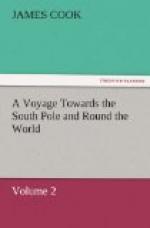Continuing to stand to N.E. with a fresh breeze at N.N.W., at two o’clock, we passed one of the largest ice-islands we had seen in the voyage, and some time after passed two others, which were much smaller; Weather still foggy, with sleet: And the wind continued at N. by W., with which we stood to N.E., over a sea strewed with ice.
At half an hour past six next morning, as we were standing N.N.E. with the wind at west, the fog very fortunately clearing away a little, we discovered land ahead, three or four miles distant. On this we hauled the wind to the north; but finding we could not weather the land on this tack, we soon after tacked in one hundred and seventy-five fathoms water, three miles from the shore, and about half a league from some breakers. The weather then cleared up a little more, and gave us a tolerably good sight of the land. That which we had fallen in with proved three rocky islets of considerable height. The outermost terminated in a lofty peak like a sugar-loaf, and obtained the name of Freezeland Peak, after the man who first discovered it. Latitude 59 deg. S., longitude 27 deg. W. Behind this peak, that is to the east of it, appeared an elevated coast, whose lofty snow-clad summits were seen above the clouds. It extended from N. by E. to E.S.E., and I called it Cape Bristol, in honour of the noble family of Hervey. At the same time another elevated coast appeared in sight, bearing S.W. by S., and at noon it extended from S.E. to S.S.W., from four to eight leagues distant; at this time the observed latitude was 59 deg. 13’ 30” S., longitude 27 deg. 45’ W. I called this land Southern Thule, because it is the most southern land that has ever yet been discovered. It shews a surface of vast height, and is every where covered with snow. Some thought they saw land in the space between Thule and Cape Bristol. It is more than probable that these two lands are connected, and that this space is a deep bay, which I called Forster’s Bay.
At one o’clock, finding that we could not weather Thule, we tacked and stood to the north, and at four, Freezeland Peak bore east, distant three or four leagues. Soon after, it fell little wind, and we were left to the mercy of a great westerly swell, which set right upon the shore. We sounded, but a line of two hundred fathoms found no bottom.
At eight o’clock, the weather, which had been very hazy, clearing up, we saw Cape Bristol bearing E.S.E., and terminating in a point to the north, beyond which we could see no land. This discovery relieved us from the fear of being carried by the swell on the most horrible coast in the world, and we continued to stand to the north all night, with a light breeze at west.
1775 February




